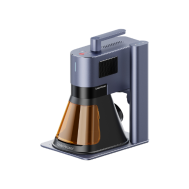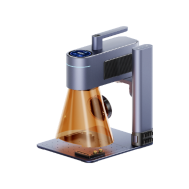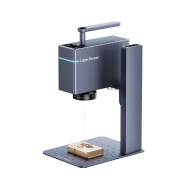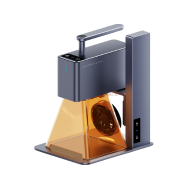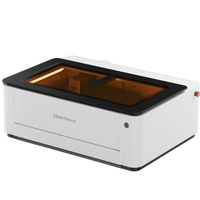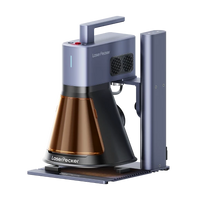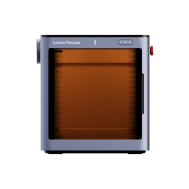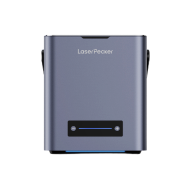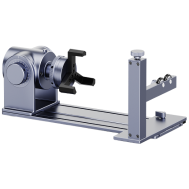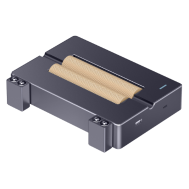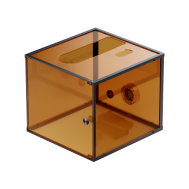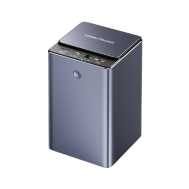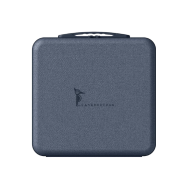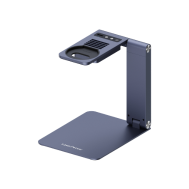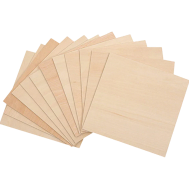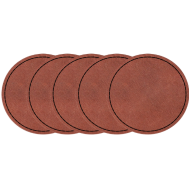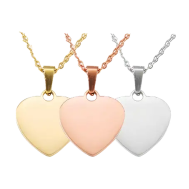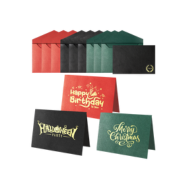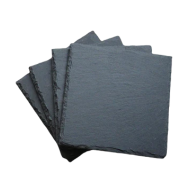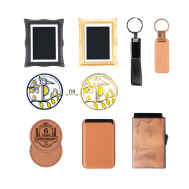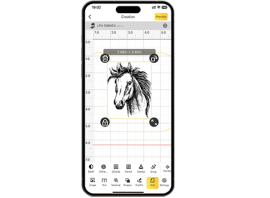The art of wood engraving has a long tradition dating back centuries. With technological advances, CNC machines and laser engraving machines have revolutionized the process. They enable precise, detailed engravings with high accuracy—without laborious hand carving.
In this article, we present the 7 best methods for engraving wood. From traditional hand engraving to modern laser engraving on wood – here you'll learn everything about the necessary tools and steps.

Contents:
- Method 1: Laser engraving wood (laser engraving machine)
- Method 2: Engraving wood by hand (carving)
- Method 3: Engraving wood with a Dremel (power tool)
- Method 4: Engrave wood with a Cricut Maker (cutting plotter)
- Method 5: Engraving wood with a CNC router
- Method 6: Pyrography on wood
- Method 7: Kolrosing wood engraving
- FAQ about wood engraving
Method 1: Laser engraving wood (laser engraving machine)
Laser engraving on wood is a modern method in which a focused laser beam precisely burns designs into various types of wood. The targeted heat vaporizes or burns the material, enabling clean, detailed engravings at high speed.

Tools required for laser engraving on wood
Wood laser engraving machine: A special laser engraving machine for wood, such as the LaserPecker 4, is ideal for detailed engravings.
Suitable wood material: The best wood types for laser engraving are hardwood, plywood and veneer.
Design software: Programs like LaserPecker Design Space allow you to create engraving files and transfer them to the wood.
Safety equipment: To protect yourself from laser beams and wood dust, you should always wear appropriate safety goggles and other safety measures.

💡 LaserPecker 4 (LP4) - The world's first dual laser engraver for multiple materials
Laser engraving wood – step-by-step instructions
Laser engraving on wood allows you to create precise and individual designs. From personalized engraved wooden signs to detailed patterns, laser engraving on wood is a popular technique for creative projects. Here you'll learn how to engrave wood and the steps required for optimal wood laser engraving.
Step 1 – Create or select a design
Create your own design using compatible graphics software or select an existing template. Make sure the design is suitable for laser engraving on wood.

Step 2 – Prepare the wood
Cut the wood to the appropriate size for your laser engraving wood project. The surface should be clean, dry, and free of dust or dirt for optimal results.
Step 3 – Adjust laser engraving settings
Depending on the type of wood, the parameters for power, speed, and resolution must be adjusted. Softer woods require less power than hardwoods. For detailed work, fine adjustments to the laser engraving settings for wood are important.
Step 4 – Fix the wood
Place the wood in the machine's work area and secure it to prevent it from slipping during engraving. A stable hold ensures precise results.
Step 5 – Upload file and start engraving
Load your design into the control software of the wood laser engraving machine and double-check the settings. Once everything is correct, start the engraving process.
Step 6 – Monitoring and quality control
Monitor the process to ensure the laser engraving is consistent. Adjust the settings during engraving if necessary.

Step 7 – Check engraving
Once finished, check the engraved wood for any irregularities or areas that need refinishing. Fine adjustments can optimize the final result.
Step 8 – Optional finish
If desired, you can seal the engraved wood with varnish, oil or wax to protect the engraving and enhance its appearance.
Video tutorial for laser engraving on wood
Conclusion
Whether you want to engrave wooden boxes, design custom signs, or create creative patterns – with the right technology, you can have wood engraved or create your own. Choose the right material, optimize the laser engraving settings for wood, and discover the versatility of this technique!
Method 2: Engraving wood by hand (carving)
Hand-engraving wood, also known as wood carving, is a traditional technique in which artisans use specialized tools to carve detailed designs into the wood surface. This method requires skill, precision, and a great deal of patience, but allows for unique and artistic engravings.
Tools for hand wood engraving (carving)
Chisels: Indispensable tools for engraving wood, available in various shapes and sizes to enable different carving work.
Gouges: Similar to chisels, but with curved or round blades, ideal for hollowing out or shaping wood.
Mallet or hammer: Used to make controlled cuts with chisels and gouges.
Carving knife: Allows for fine details and precise engraving, especially for delicate work.
Safety equipment: Safety goggles, gloves, and a dust mask ensure safe work with sharp tools and wood dust.

How to engrave wood by hand (carving)
Step 1 – Select and prepare your design . Choose or create a suitable design for your project. Transfer the motif to the wood using tracing paper, carbon paper, or by drawing directly onto it.
Step 2 – Select and prepare the wood species . Choosing the right wood species significantly influences the engraving result. Softer wood species such as basswood or pine are particularly well suited for wood engraving. The surface should be clean and smooth to achieve precise results.
Step 3 – Secure the wood Secure the wood with clamps or a screw clamp to prevent it from slipping while carving.
Step 4 – Begin Engraving Start with a rough outline of the design before gradually adding more depth and detail. Use chisels, gouges, and carving knives.
Step 5 – Perform precise carving movements. Always work with the wood grain to avoid cracks or chipping. Use controlled movements for clean wood engraving.
Step 6 – Adding Finishes and Details Once the rough outline is complete, refine the details and even out any differences in depth. Any unevenness can be corrected with fine cuts.
Step 7 – Finishing and Protecting Sand the engraved surface to smooth it. Optionally, apply a wood preservative or finish to seal the wood engraving and increase its durability.
Conclusion
Engraving wood yourself is an artistic technique that requires skilled craftsmanship but allows for exceptionally unique results. Whether you want to engrave a wooden box, create an engraved wooden sign, or create a decorative inscription – with the right tools and a little practice, you can create impressive designs!
Video tutorial for engraving wood by hand
Method 3: Engraving wood with a Dremel (power tool)
Engraving wood with a Dremel is a modern and efficient method for carving detailed patterns and designs into wood. Thanks to its high speed and various engraving attachments, the Dremel enables precise and fast work—ideal for craftspeople and hobbyists who want to create fine wood engravings themselves.
Tools required for wood engraving with a Dremel
Dremel multi-tool: A handy, powerful power tool with various attachments for wood engraving.
Engraving bits: Special attachments for fine wood engraving, suitable for different depths and details.
Safety equipment: Safety goggles, gloves, and a respirator mask protect against wood dust and splinters.
Screw clamps or clamping devices: Fix the wood during the engraving process and ensure stability.

Step-by-step instructions: Engraving wood with a Dremel
Step 1 – Prepare the design: Choose or create a suitable design. Transfer it using tracing paper or draw it directly onto the wood surface.
Step 2 – Prepare the wood: Choose a suitable wood species for the project. The surface should be clean, smooth, and free of any imperfections.
Step 3 – Secure the wood: Clamp the wood firmly with screw clamps to prevent movement during the engraving process.
Step 4 – Choose the right engraving bit based on the desired depth and level of detail.
Step 5 – Start engraving: Hold the Dremel with a steady hand and first trace the contours of the design. Then you can add detail and depth.
Step 6 – Control and Precision: Work with smooth movements to ensure consistent depth. Adjust the speed and pressure depending on the wood type and motif.
Step 7 – Fine-tuning: Refine the details and smooth out rough areas for a high-quality wood engraving. Regularly remove wood dust for better visibility and precision.
Step 8 – Finishing: After engraving, the surface can be lightly sanded to remove any unevenness. A wood finish or sealant protects the wood engraving and provides a sophisticated appearance.
Video tutorial: Engraving wood with a Dremel
Method 4: Engrave wood with a Cricut Maker (cutting plotter)
Engraving wood with the Cricut Maker offers a modern and automated way to transfer precise designs onto wood. Featuring specialized engraving blades and high-precision cutting technology, the Cricut Maker enables detailed wood engraving on various wood types—ideal for creative projects and personalized engraved wooden signs.
Tools required for wood engraving with the Cricut Maker
Cricut Maker machine: A computer-controlled cutting and engraving machine with special blades, including the fine tip and the engraving blade for wood.
Wood panels or blanks: Thin wood types such as balsa or linden wood that are suitable for engraving.
StrongGrip Mat: A special adhesive mat that holds the wood in place during the engraving process.
Computer or mobile device: For creating or uploading designs to the Cricut Design Space software.
Sandpaper and wood finish (optional): To refine the wood engraving and protect the surface.

Step-by-step instructions: Engrave wood with the Cricut Maker
Step 1 – Create or select a design: Create a custom design in compatible software or select a design from the Cricut Design Space library.
Step 2 – Prepare the wood: Cut the wood to fit the Cricut Maker's StrongGrip mat. Securely attach the wood to the mat.
Step 3 – Upload and configure your design: Upload the design file to Cricut Design Space and adjust the wood engraving settings. Select the appropriate engraving blade.
Step 4 – Load the machine: Insert the engraving blade into the Cricut Maker and load the mat with the attached wood according to the machine's instructions.
Step 5 – Start the engraving process: Start the engraving process using the Cricut Design Space software. The Cricut Maker will precisely engrave the design into the wood surface.
Step 6 – Remove and refine the wood: After engraving, carefully remove the wood and rework it with sandpaper to remove any unevenness.
Step 7 – Surface treatment (optional): If desired, apply a wood sealant or finish to protect the engraving and enhance its appearance.
Video tutorial: Engraving wood with the Cricut Maker
Method 5: Engraving wood with a CNC router
Engraving wood with a CNC router offers a highly precise and automated method for creating detailed designs on wooden surfaces. Computer-controlled, the CNC router executes engravings with impressive accuracy and consistency, making it an ideal choice for both professional craftspeople and hobbyists seeking high-quality wood engraving.
Required tools for wood engraving with a CNC milling machine
CNC router: A computer-controlled cutting and engraving machine with a rotating milling tool for precise wood engraving.
Computer with design software: For creating or uploading design files compatible with the CNC mill.
Wood material: Different types of wood such as hardwood, softwood or plywood that are suitable for engraving.
Fastening systems: Clamps or vacuum holding systems for securely fixing the wood to the router table.

Step-by-step guide: Engraving wood with a CNC router
Step 1 – Create or select a design: Create a custom design using compatible software or select an existing template for wood engraving.
Step 2 – Prepare the design file: Convert the design into a format readable by the CNC milling machine (e.g., G-code). Define the milling paths, engraving depth, and cutting speeds.
Step 3 – Prepare the wood: Cut the wood to fit the router table and ensure the surface is clean, flat, and ready for engraving.
Step 4 – Set up the CNC milling machine: Load the design file into the CNC software, install the appropriate milling tool, and calibrate the machine according to the engraving specifications.
Step 5 – Secure the wood: Secure the wood with clamps or a vacuum holding system to prevent slipping during engraving.
Step 6 – Test run and calibration: Perform a test run to ensure that the machine is correctly aligned and that the wood engraving is executed exactly according to the design.
Step 7 – Start engraving: Start the CNC milling machine and let it precisely execute the programmed milling paths on the wood surface.
Step 8 – Monitoring and Control: Monitor the process to ensure the engraving is done correctly. Adjust the settings if necessary.
Step 9 – Finishing: After completing the engraving, check the result. If necessary, refine the details with sandpaper or add a protective coating for a long-lasting wood engraving.
Video tutorial: Engraving wood with a CNC router
Method 6: Pyrography on wood
Wood engraving, also known as pyrography, is an art form that uses controlled heat to create complex designs or patterns on wooden surfaces. This technique has been practiced for centuries and allows artisans to create beautiful and detailed works of art, designs, or personalized items on various types of wood.
Tools for wood engraving (pyrography)
Wood engraving tool (pyrography pen): A specialized tool with interchangeable tips or nibs that are heated to leave branding marks on the wood. The tips come in various shapes and sizes to achieve different effects.
Wood surfaces: Different types of wood suitable for pyrography, such as basswood, pine, birch, or hardwoods, offer different textures and colors.
Carbon paper or copy paper: Used to transfer designs to the wood surface before engraving begins.
Protective equipment: Heat-resistant gloves, safety goggles, and a well-ventilated work area to protect against burns and fumes.

How to engrave wood (pyrography)
Step 1 - Design Selection and Transfer: Select or create a design suitable for wood engraving. Transfer the design to the wood surface using carbon paper or tracing paper by tracing or drawing the design directly onto the wood.
Step 2 - Wood Preparation: Prepare the wood surface by sanding it to ensure a smooth and clean canvas for wood engraving. Remove any dirt or rough spots that could interfere with the engraving.
Step 3 - Selecting the Right Tip: Choose the appropriate tip or nib for the wood engraving machine based on the complexity and style of the desired design.
Step 4 - Test and Adjust the Heat: Test the wood engraving tool on a scrap piece of wood to determine the heat intensity and the interaction of the selected tip with the wood. Adjust the heat level as needed to achieve the desired effects.
Step 5 - Begin engraving: With a steady hand and controlled movements, begin burning the design onto the wood surface. Use consistent pressure and speed to achieve even and precise burns.
Step 6 - Shading and Detailing: Use different techniques, such as varying pressure, strokes, and tip angles, to create shading, depth, and finer details in the design.
Step 7 - Cooling and Finishing: After the engraving process is complete, allow the wood to cool. Optionally, you can apply a sealant or finish to the wood surface to protect the artwork and enhance its appearance.
Video tutorial for wood engraving
Method 7: Kolrosing wood engraving
Kolrosing is a traditional Scandinavian woodcutting technique used to create intricate designs, patterns, or decorative elements on wooden surfaces. Originating in the Nordic regions, kolrosing involves scoring or scoring the wood with fine lines that are filled with various materials such as pigment powder, coffee grounds, or even ash to add contrast and depth to the designs.
Tools for Kolrosing wood engraving
Sharp knife or Kolrosing knife: A thin, sharp knife with a straight blade, specially designed for fine cuts in wood.
Wood surface: Various types of wood, preferably soft woods such as basswood or pine, are well suited for kolrosing because they are easy to cut and mark.
Filling materials: Substances such as coffee grounds, pigment powder, ash, or other fine materials used to fill the incisions and create contrast.

How to engrave wood with Kolrosing
Step 1 - Design Planning: Select a design or pattern suitable for colrosing. Simple geometric shapes, lines, or small decorative motifs work well for this technique.
Step 2 - Wood Preparation: Prepare the wood surface by ensuring it is clean, smooth, and free of imperfections. This provides a suitable canvas for the coloring process.
Step 3 - Knife Cuts: With a steady hand, use the sharp knife to carefully make fine incisions or scores on the wood surface according to the planned design. Be careful not to make the cuts too deep to ensure proper adhesion of the filler materials.
Step 4 - Filling the cuts: Apply the selected filler material into the cuts on the wood surface. Use a small tool or your finger to gently press the material into the cuts to ensure they are sufficiently filled.
Step 5 - Smooth and Clean: After the cuts are filled, carefully remove any excess material from the wood surface with a soft brush or cloth. Ensure the filled lines are clean and clearly visible.
Step 6 - Optional Finishing: Optionally, you can apply a sealant or finish to protect the engraved design and enhance the appearance of the wood surface.
Step 7 - Allow to dry or harden: Allow the filled incisions to dry or harden, depending on the filling material used, to ensure they stay in place and create a permanent design.
Video tutorial for Kolrosing wood engraving
FAQs about wood engraving
1. Which types of wood are suitable for engraving?
Wood species such as basswood, pine, birch, cherry, maple and walnut are commonly used because they offer the right hardness, grain and good workability for engraving.
2. Which wood is best suited for engraving?
Alder - According to Aplazer.com, this wood meets all the requirements. It features a light color, a smooth texture, and minimal banding. Alder should be your first choice for laser engraving projects.
3. Is plywood good for engraving?
Yes, plywood can be used for engraving, but the quality varies depending on the wood veneers and adhesive used. High-quality plywood with smooth surfaces and minimal air pockets is preferable.
4. What safety precautions should be observed when engraving wood?
It's important to wear safety goggles, gloves, and a dust mask to protect yourself from wood particles. Tools should also be used correctly and the work area should be well-ventilated.
5. What are the differences between wood engraving, wood carving, etching and printing?
Wood engraving: Refers to the creation of designs or patterns on the wood surface using techniques such as carving, burning or etching.
Wood carving: Refers to the cutting and shaping of wood to create three-dimensional sculptures or reliefs.
Etching: A process in which designs or patterns are cut into the wood surface through the use of acids or abrasive substances.
Printing: Uses wood blocks or plates with engraved designs to produce printed images or illustrations.
6. How to engrave wood at home?
Traditionally, wood engraving is done at home using hand tools such as chisels and gouges. However, for a modern and precise method, a mini laser engraver is an excellent choice. Its operation is similar to that of a printer, offering precision and simplicity in the engraving process.
Conclusion
Wood engraving is a fascinating art form that offers a variety of techniques—from traditional hand tools like chisels to modern methods like laser engraving on wood. This art allows for the creation of intricate designs, personalization of objects, and impressive decorative pieces. It requires attention to detail, patience, and skill, making it a rewarding pursuit for both hobbyists and professionals.
Whether you prefer traditional methods or want to explore innovative approaches like laser engraving on wood, wood engraving invites creativity and artistic expression. It transforms wooden surfaces into extraordinary works of art and demonstrates the fusion of tradition and innovation in the world of woodworking.
















